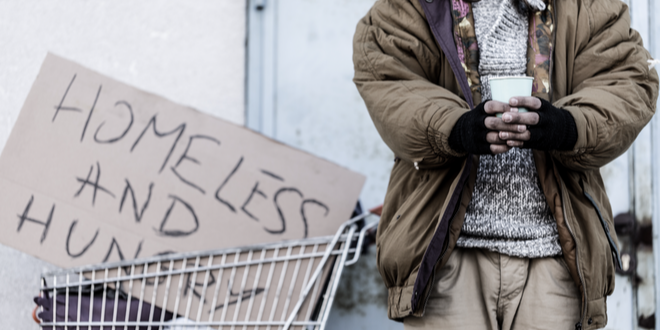Sometime in the next few weeks, San Bernardino expects to begin cleaning out its homeless encampments from the city’s parks. The city will take that action because a court injunction that prohibited the city from conducting such cleanups was lifted last month, nine months after it was put in place. The injunction was the result of a lawsuit filed against the city last year regarding its treatment of homeless people.
City staff will post cleanup notices throughout the city in English and Spanish, letting people know at least 72 hours in advance that an encampment is about to be removed, according to a five-page plan released by Oct. 2 by San Bernardino staff. That document was made public during a during a news conference in front of city hall. All notices will include a start time and an estimated end time. When needed, special attention will be given to disabled people by the city’s Americans With Disabilities Act coordinator, or a designee.
If a cleanup doesn’t happen within three hours of its posted time, it must be rescheduled and new time must be posted. The cleanup crews will also be required to wear body cameras during the cleanups. No personal belongings will be thrown away, and no items will be treated as trash unless the owner of the items in question identifies them as trash. The cleanup plan defines trash as discarded matter or refuse. Also, homeless individuals who are moved will be offered shelter opportunities, including hotel vouchers and space in nonprofit shelters where such space is available.
Reducing its homeless population isn’t the only major task the city is undertaking at the moment. The city is also working on replacing the Carousel Mall, which was leveled earlier this year, and replacing it with a mix of retail, residential and commercial development. It is also trying to restore city hall at 290 N. D St., which has been closed since 2017 so that it can be brought up to seismic standards. Both of those are major tasks – the Carousel Mall project could take years to complete – but neither of them is at the top of San Bernardino’s to-do list, according to Mayor Helen Tran. “[Homelessness] is the number one concern we hear from our residents,” said Tran, who spoke at a news conference on the steps of city the day the cleanup plan was released.
San Bernardino is not the only city trying to reign in its homeless population and help those individuals not only find a permanent place to live but get their lives back in order. The problem is nationwide. “Homelessness is a problem everywhere,” Councilwoman Sandra Ibarra said during the news conference. “It can be found from here to Washington, D.C.” The cleanup plan settled a lawsuit filed against the city in August 2023 on behalf of three homeless Individuals.
The suit was filed by the ACLU Foundation of Southern California and The SoCal Trash Army, a volunteer non-profit organization that helps homeless people Riverside and San Bernardino counties. It alleged that the city illegally seized the personal property of all three plaintiffs, in violation of their constitutional rights, among other alleged infractions.
In the case of one plaintiff who was living in Meadowbook Park, a city cleanup crew threw away much of that person’s personal property into a trash can, including a walker, first-aid kit, suitcase and her medical records.
Based on that suit, U.S. District Judge Terry J. Hatter Jr. in January issued a preliminary injunction that prevented San Bernardino from removing homeless people, or their belongings, from an encampment. The 16-page ruling required San Bernardino staff to come up with a plan for cleaning up those homeless gatherings, which can be found throughout the city but are common in its parks.
San Bernardino’s homeless population has grown because of the injunction, and it remained in place despite two developments that might have helped the city to get the problem under control: A U.S. Supreme Court ruling in June that allows cities to prohibit homeless encampments and, in August, a declaration by Gov. Gavin Newsom that he would consider withholding funds from cities if they did not get their homeless populations under control.
On Sept. 25, Hatter lifted the injunction after reading the cleanup plan reached between the city, the ACLU Foundation and SoCal Trash Army. That document spells out how the city will deal with its homeless population in the future and, it hopes, avoid more lawsuits. For example, from now on, when a homeless encampment is cleared, the people living there will be given colored plastic bags in which to place their belongings. Those bags will be stored for 90 days and overseen by the public works department. If not collected within 90 days the property may be destroyed. “The personal property of unhoused persons must not be treated differently than the property of other members of the public,” the cleanup agreement states. “City staff should use reasonable care when handling, collecting and retaining the personal property of unhoused persons.”
Also, a disabled homeless person may ask for a “reasonable accommodation,” including temporary wheelchair access, walker access, hotel vouchers, transportation assistance, and extra time finding a permanent place to live. City staff will explain in writing any accommodation request that is denied. The cleanup agreement is the result of extremely difficult negotiations, according to Councilman Theodore Sanchez. “Getting this agreement was about as tough as getting any agreement like it can be,” Sanchez said. “We’ve been working on this for the better part of a year, and the goalposts kept moving. But we have an agreement that was negotiated in good faith, and we voted for the agreement unanimously.”
Besides the cleanup agreement, San Bernardino is working on bringing two homeless shelters to the city: a 140-bed facility expected to open in January at 1354 G St. and a second shelter at 796 Sixth St. that is out for bid. City officials hope to have that project open in about one year. San Bernardino’s effort to gets its homeless problem is good news for the city’s businesses, said Cliff Cummings, owner of Toyota of San Bernardino and Subaru of San Bernardino at the San Bernardino Auto Center. “Homelessness is very much an issue for businesses, and it’s good that the city is doing something about it,” said Cummings, who said he has had to have some homeless people removed from both of his dealerships. “San Bernardino has become ground zero (in the Inland Empire) for homelessness, but it’s starting to get out of that hole.”
 IE Business Daily Business news for the Inland Empire.
IE Business Daily Business news for the Inland Empire.


